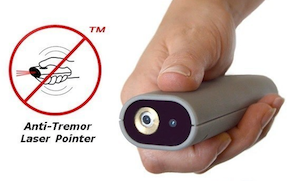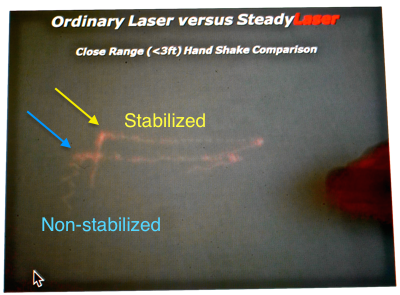Home
A comprehensive resource for safe and responsible laser use
US: "SteadyLaser" pointer said to reduce hand motion

The SteadyLaser
The first version being sold on Kickstarter contains two Class 2 (<1 milliwatt) 635 nanometer red laser modules. The module on the left (in the photo above) is suspended inside the TV-remote sized SteadyLaser. It provides the stabilized beam. The other laser is non-stabilized, like a standard laser pointer. In the final Kickstarter version, the user can choose either either the stabilized beam or the normal beam, but — for safety reasons — not both at once.

This is a 2-second exposure, from a Kickstarter video, showing both beams being emitted simultaneously in order to demonstrate the stabilization’s effect. The line traced by the stabilized laser is up and to the right of the non-stabilized laser’s line.
Pricing for the initial run of 1000 SteadyLasers is approximately $150 each. It is promoted on Kickstarter solely for presentations in professional locations such as businesses, schools and courts. The primary benefits are claimed to be minimizing distraction, and reducing the appearance of nervousness when using a laser pointer in presentations.
The Kickstarter page first went up approximately April 10 2015. As of April 13 there were 6 backers pledging $960. The goal is to get $150,000 in backing by June 9 2015; otherwise the laser will not become a product — or at least, not through Kickstarter.
Regardless of the Kickstarter outcome, the inventors want to license their patents to current laser pointer manufacturersd.
From SteadyLaser.com, the SteadyLaser Kickstarter page, and Sys-Con Media via PRNewswire
Commentary from LaserPointerSafety.com
There could be concern over a handheld laser that can remain steady on a target. If aimed at an aircraft’s cockpit, the beam would be able to stay in a pilot’s vision longer than a standard, non-stabilized laser pointer.
Because of this potential hazard, LaserPointerSafety.com contacted co-inventor Jeff Wilson, who kindly agreed to add an aviation safety warning to the SteadyLaser’s labeling, with text such as “Do not aim at vehicles or aircraft. This is hazardous and illegal.”
The first-generation SteadyLaser has low power (1 mW) and low apparent brightness (635 nm red, which appears only 25% as bright to the human eye as the common 532 nm green laser). Assuming a 1 milliradian divergence, the SteadyLaser is an eye hazard to 23 feet, can cause flashblindness up to 55 feet from the laser, can cause glare up to 245 feet, and would be a distraction to pilots (brighter than other city and airport lights) up to a half mile from the laser.
However, if future versions had more power — up to the U.S. FDA’s limit of 5 mW for laser pointers — and used a 532 nm green laser, then the hazard distances would increase as follows: eye hazard to 52 feet, flashblindness to 245 feet, glare hazard to 1,097 feet, and distraction hazard to 2.2 miles.